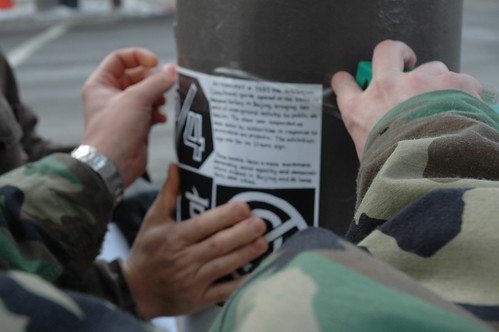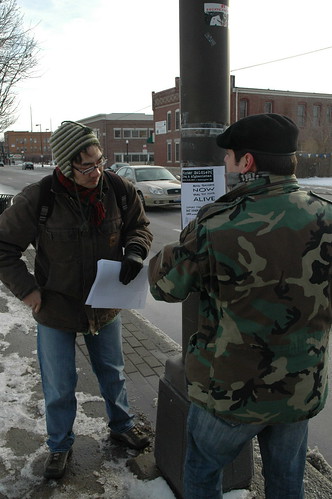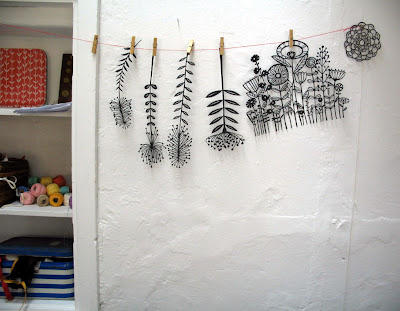Friday, February 29, 2008
link
http://www.ekosystem.org/
Thursday, February 28, 2008
Harrel Fletcher
Wednesday, February 27, 2008
Even Dog POo can be a Good Medium...
Spectacle + Social Space
Tuesday, February 26, 2008
Trouble
I make posters and fliers and zines all the time to get the word out about events and ideas that are brewing out of the veteran’s community. So to be able to make my own silkscreen prints was a major plus. However, once I started working on designs and layouts I started to feel like the mass production of these supposed art objects seemed to only be creating more commodity. Or perhaps I can say it a little better… It seemed that all the materials that I was producing were already reified or consumed and there was little potential for them to rupture the everyday. Perhaps these objects do not need to rupture but can function solely as information. But in our everyday that is overly mediated and a space of information overload what is the responsible thing to be producing and inserting into social spaces.
What you all think? Does it matter…

Social Practice in Practice

Last week I was out in Columbus Ohio contributing to a project by Red76.
The project revolves around a public copy center call the VDC.
Here is the opening quote on the VDC web page, “The Anti-War group, Vietnam Day Committee, was founded in May of 1965 in Berkeley, California; the outgrowth of a two-day long teach-in which gathered a crowd of 35,000 plus. This massive group learning session went on to form one of the earliest, and most inventive, anti-Vietnam War organizations in America at the time. Some of its founders - such as Stew Albert and Jerry Rubin - went on to found the Youth International Party just a few years later. The offices of the VDC had an extremely interesting open-door policy. The origins and actions of this particular open-door office policy serve as a jumping-off point for the VDC Copy Center initiative. We'd like to tell you more...”
Iraq Veterans Against the War Chicago and myself were invited out to help kick the space off. So we went on an organizing road trip of Ohio… doing speaking events and building support for the veterans movement. At the copy center we talked about recruitment and our experiences in the military. Then we all went to work making counter recruitment fliers and screen-printing T-shirts. Over all a lot of materials were produced and then distributed across Columbus… Check out the links.
BLOG
On Printing with Tomato Sauce

butter

sauce
Monday, February 25, 2008
Zine, Substitution and Garment

For my substitution project I printed several versions of a television stencil onto books and placed them in book stores in sections that were related. I placed one in the Radio/TV section.
I printed on the Feminine
 Mystique and placed it in the Women's Studies section. I place Passions within Reason in the Romance novel section.
Mystique and placed it in the Women's Studies section. I place Passions within Reason in the Romance novel section.I used an exacto knife to cut a power button onto every page of the Feminine Mystique and volume controls on Passions within Reason.




I also experimented with the televisions stencils on black and gray striped pieces of cloth. I tacked these onto the outsides of buildings.

I

 printed onto 4 shirts: a vest, a bra, breasts, and a skeleton. On each I printed a string of pearls as
printed onto 4 shirts: a vest, a bra, breasts, and a skeleton. On each I printed a string of pearls as  well. The intension was that this project would work as a performance of a sort of stripping in the public space. This was suggested during a crit-it can also function throughout a week, each day revealing more as I fall apart during the week.
well. The intension was that this project would work as a performance of a sort of stripping in the public space. This was suggested during a crit-it can also function throughout a week, each day revealing more as I fall apart during the week.
Inspiration?

Sunday, February 24, 2008
I BELIEVE ANITA HILL
Friday, February 22, 2008
To Be Brief: Undies in the Social Space.
http://www.hour.ca/news/news.aspx?iIDArticle=11097
which details a canadian safe sex and AIDS awareness movement that used printed underwear for their cause. I think this group's use of the same garment points out a potential reading of my piece (were it not for my tags) that would suggest something different, perhaps suggesting I was in fact looking for a lot more of this kind of public condom "flyering".
My question is, why weren't they just handing out condoms?
Interesting, nonetheless.
And here are some of my pictures:
Wednesday, February 20, 2008
More Barbara Kruger... and bags
It also poses some interesting questions about context and substrate. For instance, how does this work of image-text commentary...

change when it's printed on a shopping bag or a canvas tote?


... does it operate any differently when it's adopted as witty packaging by department stores? Or printed on a canvas tote bag and sold as a consumer item for $30 by the Museum of Modern Art? Does this operate as infiltration or cooptation... or something else?
More on Kruger's practice of multiple-making in an excerpt from Jennifer Roberts' essay in Artists and Prints: Masterworks from The Museum of Modern Art, New York: The Museum of Modern Art, 2004, p. 244:
The techniques of photolithography and screenprint are ideally suited to Kruger's strategies of appropriation and replication of imagery from mass culture, and they are used throughout her work, whether large-scale and unique, or ephemeral and printed in thousands of copies. Her ephemeral works, which dramatically fulfill the democratic potential of printmaking to bring art to wide audiences, range from book, magazine, and compact disc covers to matchbooks, coffee mugs, and shopping bags. It is noteworthy that visual strategies she appropriated from the mass media have been returned to their sources on covers she created for such magazines as Newsweek and Esquire. In addition, countless graphic designers have adopted her visual style.
A rare example of her venturing into the area of the traditional limited edition is her illustrated book My Pretty Pony by Stephen King, part of an innovative project pairing artists and writers, established at the Whitney Museum of American Art. Unsurprisingly, the book is also available in a trade edition version for greater accessibility.
******
Two other interesting takes on the artist-designed shopping bag can be found in Jeremy Deller's and Franco B's commissioned projects, the contexts of which are described HERE.
Barbara Kruger





In the stencil project that we just completed I explored the appropriation of advertising for use in a different format and for a different purpose. Barbara Kruger appropriates images from ads and magazines for her work, some of which involves the process of photographic silkscreening on vinyl and plexiglass. Above are some examples of her silkscreening work. You can find out a lot more about the artist as well as a list of articles relating to her at http://www.maryboonegallery.com/artist_info/kruger_info.html
~Emma
Tuesday, February 19, 2008
Cayetano Ferrer



UR Magazine Article
Saturday, August 5, 2006 5:31 PM
UR Chicago Magazine, August 2006
In early spring of 2004, Chicago drivers trying to determine if a stretch of empty curb doubled as legal parking were confronted with a strange phenomenon. The street signs were invisible. Cayetano Ferrer, then in the midst of BFA studies at the School of the Art Institute, deployed a classic optical illusion on the modern urban landscape, erasing "No Parking" signs not through removal, but by covering each sign with an image of the precise scenery it blocked. Seen from the right angle, the red-and-white squares of metal became part of a seamless vista of sky and tree branches.
"I am interested in site specificity because I feel like it's easy to get lost in repetition," says Ferrer, a Las Vegas native who graduated a few months ago. "Those 'No Parking' signs are everywhere, and that kind of attracted me to using them as a way to frame these places in the city."
Named for the words that remain visible on the reclaimed parking signs, the "City of Chicago" series shares an attitude with Ferrer's more recent work. Earlier in the summer, he recreated a store aisle on Division using empty packages, the molded plastic shells outlining the items they used to contain. He's crammed everything he owns into a crate and put it up for auction on eBay, the reserve price set to the amount of his student loans.
"It's less about the disparity among people's belongings than trying to realize what convinced me, and others, that I needed so much," Ferrer explains. "I'm not trying to make a global statement about how people should live, but I personally want to experiment in alternatives. I think that if you've come to the conclusion that you don't really need much to be happy, then all of a sudden, you become rich."
For Ferrer, things don't just take up space so much as organize our impressions of the world, which means that they don't even have to be present, so long as traces of them remain -- just enough to get the point across. Ferrer is as much a minimalist as anyone can be without embracing the minimalist aesthetic.
"Situated against minimalist sculpture that has this pure materiality, [my work] is kind of the opposite, being filled with an array of objects which, for me, have these detailed histories," Ferrer says.
Like minimalists, Ferrer is about stripping away, but instead of removing formal elements -- a minimalist impulse that has been criticized as cold -- his philosophy is minimalist while his technique is not. Ferrer is intensely personal, wrenching things away from their relational significance to himself, only to yoke them back together in unexpected ways: "Once you get over yourself, it allows for good introspection about something you made to happen," Ferrer says of "Everything I Own" (the eBay piece). "This was definitely intended to be a kind of cleanse. I have been interested in representing emptiness, or (in) creating voids by erasing things."
Not that there aren't things worth owning. Ferrer emphasizes that usefulness is a personal thing, and that objects have value in their immediate usefulness -- a strangely rigid, utilitarian idea coming from an artist. What, after all, is the use of art? When "Everything I Own" didn't find a high bidder online, Ferrer set up "The Demolition Sale" in a condemned building in East Village on Hermitage and sold his stuff, piece by piece, over the course of a week.
"I think all things are worth having at the right time to the right person," he says. "I don't personally see myself hanging on to anything forever, but I guess tools are the most important for me."
For now, those tools are a wallet with a bottle opener and a tape recorder, and Ferrer says he would like a leatherman. "I can't really say what the balance is -- I'm still trying to find it myself," he says. "I feel like I might be on the other side of an imbalance where I freak out when I have more than I can carry in my backpack."
He'll be taking that backpack to Argentina in the winter, and while his work might seem to be limited by a particularly American understanding of surplus, Ferrer argues that his travels might reveal the universality of his work.
"I think people in poor countries probably have a better idea of it than we do, since most of the production is done on their land," he says. "I'm fully aware that it's because of the excess of others that I can live without so much. I would like to think that there are spaces for personal utopias within the cracks of the grand scheme. I'm trying to find those spaces and maybe expand them."
words: Suzanne Wu
Monday, February 11, 2008
Stencil Project



Hello Fellow Classmates!
Here are a couple pictures from my stencil project. The Although I printed the stencil on lots of different things(paper, gauze, wood, cardboard), the one I chose to install was the one on a wood panel. I then nailed the wood panel onto other wooden boards that blocked up a boarded up building off of the Bryn Mawr El line. You could see the parking lot where it was located from the platform, but mostly it got pedestrian traffic.
I took these pictures a couple of weeks ago, and since then I have gone back to my installation spot to see what it looked like after that big snowfall we had last week. The board was no longer there, someone unnailed it and took it - guess someone wanted to keep it.
Sunday, February 10, 2008
Wednesday, February 6, 2008
LTLYM and "significant outfits"


As we have been focused on the garment as of late, Learning to Love You More's assignment #55 came to mind. I think putting the biography of a sentimental outfit up on the world wide web for public perusal is a very interesting, vulnerable move. I particularly love the voyeur feeling I get when I read the entries that are addressed to some specific "you". I have thought at length about the outfit(s) I would post... but they are all too emotional for me to want other creeps like me to have a gander at! I picked two good ones, but check the link for more. I realize this all may have less to do with silk screening than with social space...but with social space, it has much to do indeed. As a last (side) note, I really, really like looking at the different floors upon which people displayed their outfits...
http://www.learningtoloveyoumore.com/reports/55/55.php
Monday, February 4, 2008
Postcard Art



In response to the post about mail art, I wanted to bring attention to one of the most successful mail art collaboratives currently in progress. Originally founded by artist Frank Warren, PostSecret, available at postsecret.com, is a project where viewers are encouraged to send in their secrets anonymously on the back of a homemade postcard.
These secrets represent a wide variety of emotions and experiences, and Frank has received over 2,500 postcards from around the world since January 1st, 2005. More information about the project itself can be found on the website, as well as on http://en.wikipedia.org/wiki/Postsecret. PostSecret has had numerous art exhibits nationwide.
As the website is updated every week, the previous secrets become unavailable, although Frank publishes a book that contains these secrets annually.
















